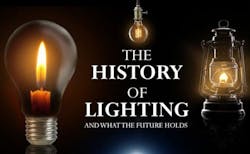The History of Lighting
The history of lighting dates back some 70,000 years when, according to the Illuminating Engineering Society, “the first attempt at man-made lighting occurred… [and] the first lamp invented was made of shell, hollowed-out rock, or other similar non-flammable object which was filled with a combustible material (probably dried grass or wood), sprinkled with animal fat (the original lighter fluid) and ignited.” Lighting technology has come a long way since then with the next major advancement being the invention of gas lamps and electric lamps in the 18th and 19th centuries.
Invention of Gas Lamps
Developed in England in 1790 and introduced to the United States a short time after by William Murdoch, gas lamps first lit up streets in Newport, Rhode Island in 1972. It was only a few decades later that Murdoch’s gas lamps lit up streets in major U.S. cities on the east coast, including Baltimore and Philadelphia. During this period, different versions were created using various types of gas, including methane, butane, propane, hydrogen, acetylene and natural gas.
Invention of Incandescent Electric Light Bulbs
The first electric lamp was invented by Englishman Humphry Davy. In 1809, Davy’s creation came to life after connecting two wires to a battery and then attaching it to a strip of charcoal between the wires’ other ends. What he created was what is commonly known as the arc light, with modern day versions in use today.
Shortly thereafter in 1879, Thomas Edison developed the first incandescent electric light bulb. Edison wanted to invent something to replace the gas lamps of the time and that could also be used indoors. His first successful light bulb burned for a full 13.5 hours, but it wasn’t ideal for pushing electricity forward as a main power source. After several more attempts, he finally created a version of the light bulb that used a carbonized bamboo filament and burned for 1,200 hours. This was the moment that advancements in modern lighting had begun and it is what brought the lighting industry to where it is today.
Invention of High-Intensity Discharge (HID) Lamps
During the 20th century, innovation in the lighting industry exploded. Shortly after Edison’s invention of the long-lasting incandescent electric light bulb, Daniel McFarlan Moore created fluorescent light around 1904 for commercial use. These lights in the early days were highly energy efficient, but required high voltage and special connectors to operate properly. Inventions of lights like this prompted other light manufacturers, like General Electric, to redesign their incandescent light technology to be more energy efficient so it could compete with the new fluorescent light technology.
It was also around this time at the beginning of the 20th century that Peter Cooper Hewitt developed the first high-efficiency, mercury-vapor light that was compatible with standard electrical infrastructure. From there, other HID lamps using the same technology were created, including high-pressure and low-pressure sodium lamps and metal-halide lamps. All of these HIDs operated the same, but there was one that stood out from the rest – the light-emitting diode, or the LED.
Modern Lighting Technology
Today, the most commonly used lighting technology is the LED, which was first invented in the 1960s by a scientist named Nick Holonyak who worked for General Electric. This type of light is what is called a solid-state light (SSL) as it produces light by converting an electrical current using a semiconductor and it does not require the same type of glass housing as traditional incandescent light bulbs.
What the Future Holds for the Lighting Industry
The invention of the long-lasting electric light bulb changed the way people lived and conducted business during the time of Edison. It also paved the way forward for the lighting industry and got it to where it is today. The creation of the LED light has proven that there is plenty of room for innovation and growth in the lighting industry in the coming decades. As modern lighting has continued to improve across the board, LED lights still show the most promise as the light of choice in the 21st century. They have a lifespan that is up to four times the average of traditional light bulbs and produce high quality light at a much more efficient rate.
It’s hard to imagine that just a little over a century ago, homes were lit with gas and oil lamps. The progression of lighting technology and innovation has grown exponentially, making it possible to move ahead even faster. Some say that lasers may replace LEDs as they are more compact, produce up to 1,000 times more light, and consume 1/3 of the electricity. While this technology is still new to the lighting industry, it is promising.
Another prediction is the use of ‘smart’ lighting that automatically switches on and off via motion sensors or other technology. This could work for homes as well as in major cities to conserve energy. Imagine a city with streetlights that dimmed when the roads were empty, or change color at dangerous intersections. The possibilities for the future of the lighting industry are virtually endless.
For now, LED lights still top the list of most efficient and long-lasting. Larson Electronics carries a wide variety LED lights and fixtures for all types of commercial, industrial and outdoor needs.
